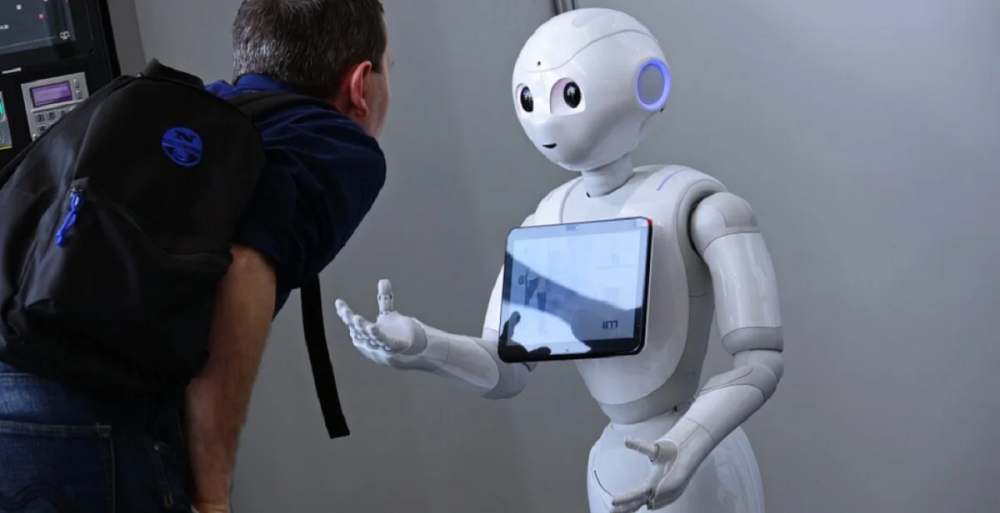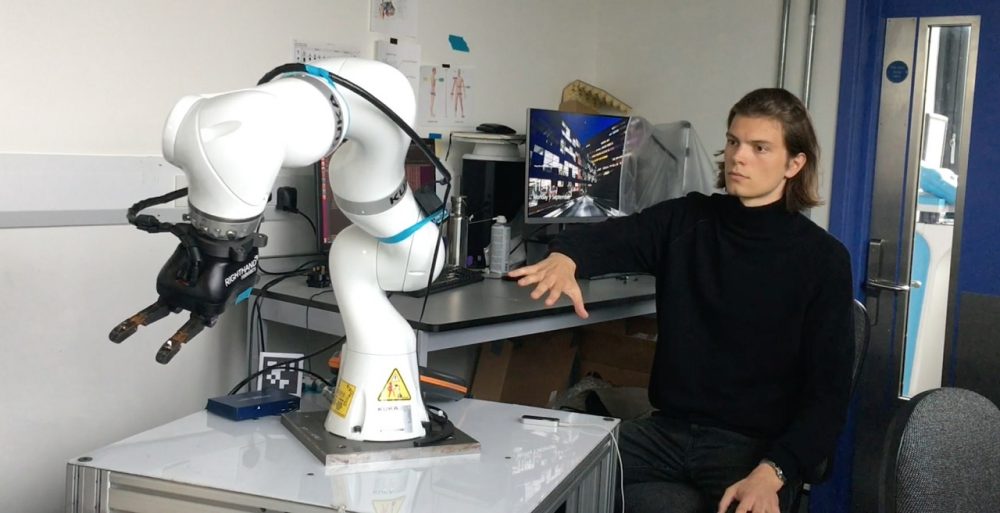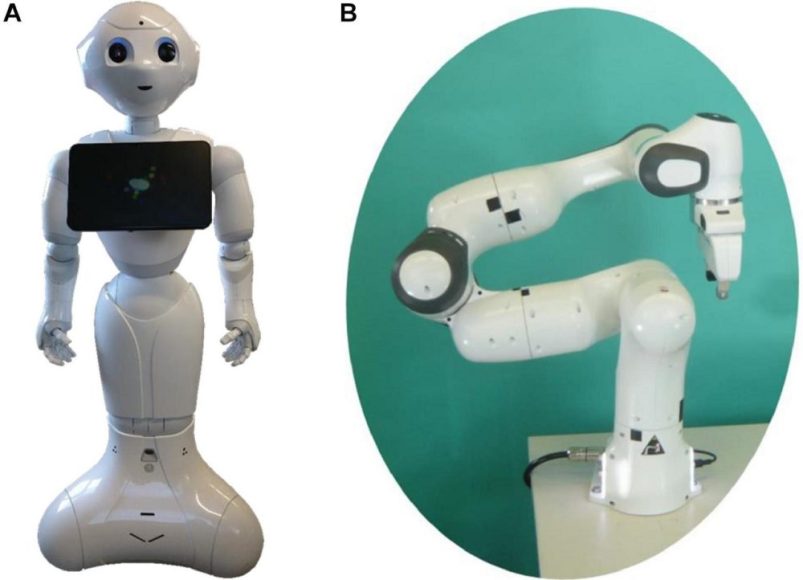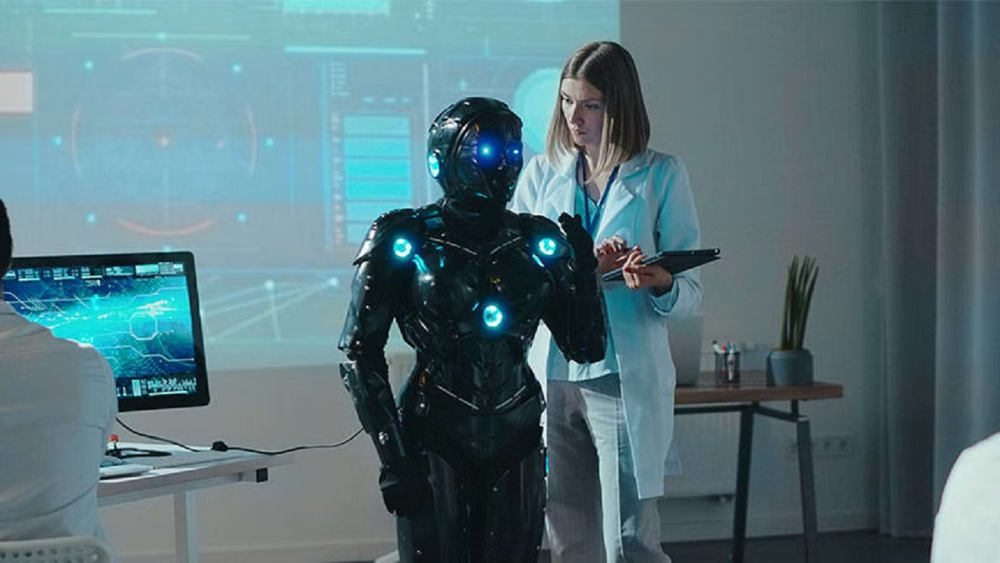Welcome to the fascinating world of Human-Robot Interaction (HRI), where humans and machines collaborate and communicate in extraordinary ways. HRI serves as a bridge, connecting the capabilities of robots with the ingenuity and creativity of humans.
In this realm, humans and robots interact seamlessly, working together towards shared goals and transforming various aspects of our lives.
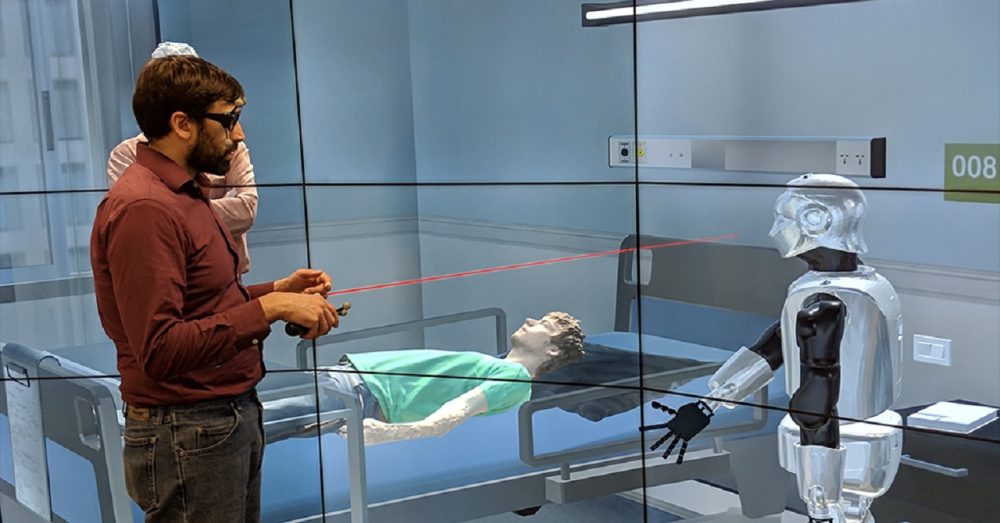
HRI encompasses the design, development, and evaluation of systems that enable effective communication and collaboration between humans and machines. It is a domain where technology and humanity converge, empowering us to unlock new possibilities and shape a future where humans and robots coexist harmoniously.
In this article, we will explore the significance of HRI, its challenges, impact, and future trends, while highlighting the ethical considerations involved.
Understanding Human-Robot Interaction
Welcome to the fascinating world of Human-Robot Interaction (HRI), where humans and robots collaborate and communicate in extraordinary ways. Here, we will explore the essence of HRI and its profound impact on our lives. Understanding Human-Robot Interaction involves delving into its definition, scope, historical evolution, and the key elements that contribute to its success.
So, let’s embark on this exciting journey and discover the wonders of HRI together.
Definition and Scope of HRI:
Human-Robot Interaction, also known as HRI, refers to the study of interactions between humans and robots. It encompasses the design, development, and evaluation of systems that enable effective communication and collaboration between these two entities.
HRI extends beyond mere human-robot communication; it explores the intricate ways in which humans and robots interact, cooperate, and work together toward shared goals. The scope of HRI encompasses various aspects, including physical interactions, verbal exchanges, and the emotional connection established between humans and robots.
Historical Evolution of HRI:
The evolution of HRI can be traced back to the early days of robotics, where the focus was primarily on using robots for industrial purposes. Over time, as robotics technology advanced, researchers and engineers recognized the need to improve the interaction between humans and machines.
The field of HRI began to emerge, driven by the desire to create robots that seamlessly integrate into our lives. From simple mechanical interfaces to sophisticated humanoid robots, HRI has witnessed significant advancements, leading to the development of intuitive and intelligent systems capable of interacting with humans in natural and meaningful ways.
Key Elements of Successful HRI:
Successful HRI involves several key elements that contribute to the quality of interaction and collaboration between humans and robots. These elements ensure that HRI experiences are engaging, effective, and user-friendly. One crucial element is intuitive interfaces, which allow users, including young children, to interact effortlessly with robots.
Clear visual cues, simple controls, and minimalistic layouts enhance the user experience and foster seamless communication. Another vital element is the ability of robots to understand and interpret human gestures, expressions, and verbal cues accurately.
Natural language processing capabilities and robust sensing mechanisms enable robots to respond intelligently to human commands and inquiries, facilitating effective communication. Additionally, the emotional connection between humans and robots plays a significant role in successful HRI.
Robots designed to exhibit empathy, understanding, and emotional responses create a sense of companionship and trust, enhancing the overall interaction experience.
By understanding the definition, scope, historical evolution, and key elements of Human-Robot Interaction (HRI), we gain insight into the incredible possibilities that arise when humans and robots collaborate.
In the following sections, we will delve deeper into the challenges, impact, design considerations, future trends, and ethical considerations related to HRI. So, join us as we explore the ever-evolving landscape of HRI and discover how it enriches our lives.
Challenges in Human-Robot Interaction
Welcome to the world of Human-Robot Interaction (HRI), where humans and robots collaborate and communicate in extraordinary ways. While HRI opens up a realm of possibilities, it also presents us with a set of challenges that need to be addressed.
Furthermore, we will explore the key challenges that arise in Human-Robot Collaboration and understand the importance of overcoming them. From anthropomorphism and emotional connection to communication and language barriers, trust and ethical considerations, and privacy and security concerns, we will delve into the obstacles that shape the dynamics between humans and robots.
So, let’s navigate through these challenges and uncover the path toward seamless HRI experiences.
Anthropomorphism and Emotional Connection:
One of the challenges in HRI is anthropomorphism, which is the tendency to attribute human-like qualities and emotions to robots. While this can enhance the emotional connection between humans and robots, it can also lead to unrealistic expectations and misunderstandings.
Robots, despite their advanced capabilities, lack human consciousness and emotions. Therefore, striking the right balance between creating a relatable and engaging robot without creating false expectations becomes crucial in HRI.
Communication and Language Barriers:
Effective communication is vital for successful HRI. However, robots and humans often face communication and language barriers. Robots must be able to understand and interpret human gestures, expressions, and verbal cues accurately.
Overcoming language barriers and developing robust natural language processing capabilities are essential for facilitating efficient human-robot communication. Clear and concise communication channels must be established to bridge the gap between humans and robots, ensuring seamless collaboration.
Trust and Ethical Considerations:
Establishing trust between humans and robots is a fundamental challenge in HRI. Humans need to have confidence in the capabilities and intentions of robots, especially when working collaboratively. Trust is built through consistent and reliable behavior demonstrated by robots.
Additionally, ethical considerations come into play in HRI. Robots must adhere to ethical guidelines and demonstrate responsible decision-making capabilities. Issues such as transparency, accountability, and the potential for bias in decision-making algorithms need to be addressed to ensure trust and ethical HRI.
Privacy and Security Concerns:
As robots become increasingly integrated into our lives, privacy and security concerns arise in HRI. Robots may collect sensitive information about individuals, making it crucial to implement robust security measures and adhere to privacy regulations to safeguard user data.
Unauthorized access to robot systems and the potential for data breaches pose significant risks. Ensuring data privacy and maintaining the security of HRI systems is paramount to fostering trust and protecting user information.
In navigating the challenges of Human-Robot Collaboration, it is essential to understand and address the complexities that arise. By overcoming these obstacles, we can foster effective communication, establish trust, and ensure the privacy and security of HRI systems.
In the following sections, we will explore the impact of HRI, design considerations, future trends, and ethical considerations, highlighting the path toward successful and seamless collaboration between humans and robots. So, join us as we embark on this journey to bridge the gap between humans and machines.
The Impact of Human-Robot Interaction
Welcome to the exciting world of Human-Robot Involvement (HRI), where humans and robots collaborate and communicate in extraordinary ways. Beyond the challenges and complexities lies a realm of the impact that HRI has on our society and industries.
Moreover, we will explore the profound effects of Human-Robot Collaboration and understand how it transforms various domains. From the advantages of collaborative robotics to the wide-ranging applications in different industries and the enhancement of efficiency and productivity, we will uncover the power of HRI in shaping our present and future.
So, let’s dive into the impact of Human-Robot Involvement and witness the remarkable potential it holds.
Advantages of Collaborative Robotics:
Collaborative robotics, also known as cobots, represents a significant advantage in HRI. These robots work alongside humans, complementing their skills and capabilities. By taking over repetitive or physically demanding tasks, cobots free up human workers to focus on more complex and creative endeavors.
This symbiotic relationship between humans and robots leads to improved efficiency, increased productivity, and enhanced workplace safety. Collaborative robots facilitate seamless cooperation between humans and machines, creating a harmonious environment where their combined strengths can be harnessed to achieve optimal results.
Applications of HRI in Various Industries:
HRI finds applications in a multitude of industries, revolutionizing the way tasks are performed and opening up new possibilities. In healthcare, robots assist surgeons during surgeries, enabling precision and reducing the risk of human error.
They can also provide support in patient care, monitor vital signs, and offer companionship to individuals in need. In manufacturing, robots automate assembly lines, working side by side with human workers to streamline production processes and enhance efficiency. HRI is also making strides in education, where robots can act as tutors, engaging children in interactive learning experiences.
Furthermore, in the realm of personal assistance, robots aid individuals with disabilities, assisting them in daily activities and improving their quality of life. These applications are just a glimpse of the vast potential of HRI across industries.
Enhancing Efficiency and Productivity through HRI:
One of the most significant impacts of HRI lies in the realm of efficiency and productivity. By seamlessly integrating robots into human workflows, HRI optimizes performance and output. Robots possess the ability to execute tasks with precision, speed, and consistency, reducing errors and minimizing downtime.
This translates into improved operational efficiency, cost savings, and increased productivity for businesses. The collaboration between humans and robots creates a synergistic environment, where each party can focus on their strengths, ultimately leading to enhanced overall performance.
As we explore the impact of Human-Robot Involvement, we witness the advantages of collaborative robotics, the wide-ranging applications in various industries, and the transformation of efficiency and productivity.
The dynamic interplay between humans and robots unlocks new possibilities, propelling us toward a future where technology and human capabilities converge to achieve remarkable feats.
In the following sections, we will delve deeper into the design considerations, future trends, and ethical implications of HRI, uncovering the potential for further innovation and the responsible deployment of this transformative technology. So, let’s embark on this journey and embrace the power of Human-Robot Collaboration.
Designing Effective Human-Robot Interaction
Welcome to the realm of Human-Robot Interaction (HRI), where humans and robots collaborate and communicate in remarkable ways. Designing effective HRI experiences is crucial to ensure seamless interaction and engagement between humans and machines.
Here, we will explore the key principles and considerations in designing interfaces for Human-Robot Collaboration. From user-centered design principles to intuitive interfaces, feedback mechanisms, and personalization and adaptation, we will delve into the elements that contribute to the success of HRI.
Join us on this journey as we uncover the art of designing effective Human-Robot Involvement experiences.
User-Centered Design Principles:
At the core of designing effective HRI is the adoption of user-centered design principles. Understanding the needs, capabilities, and limitations of the users is paramount.
Designers must empathize with users, including young children, and create interfaces that are intuitive, accessible, and inclusive. By focusing on the end-users, designers can ensure that the HRI experiences cater to their preferences, making the interaction more engaging and meaningful.
Designing Intuitive Interfaces:
Intuitive interfaces are key to facilitating seamless interaction between humans and robots. Clear visual cues, simple controls, and minimalistic layouts contribute to an intuitive design that enables users, including young children, to interact with robots effortlessly.
By employing familiar and recognizable design elements, such as icons and visual representations, the learning curve is reduced, and users can quickly grasp how to interact with robots.
Incorporating Feedback Mechanisms:
Feedback mechanisms play a crucial role in HRI, enhancing the overall user experience. Robots should provide clear feedback to humans, indicating their understanding of commands and actions.
Visual cues, auditory signals, or haptic feedback can be incorporated to communicate the robot’s status, response, or any relevant information to the user. Effective feedback mechanisms help build trust, enhance communication, and ensure that humans and robots are on the same page during the interaction.
Personalization and Adaptation in HRI:
Every user is unique, with distinct preferences and requirements. Personalization and adaptation in HRI allow for a more tailored and engaging experience. Robots can be designed to adapt to user preferences, learning from past interactions and adjusting their behavior accordingly.
By personalizing the HRI experience, robots can create a stronger sense of connection and familiarity with users, making the interaction more enjoyable and meaningful.
In designing effective Human-Robot Interaction, user-centered design principles, intuitive interfaces, feedback mechanisms, and personalization and adaptation are paramount.
By focusing on the needs and preferences of users, incorporating intuitive and responsive interfaces, and providing meaningful feedback, we can create HRI experiences that bridge the gap between humans and machines.
In the following sections, we will explore the future trends, ethical considerations, and the broader impact of HRI, highlighting the potential for further advancements and responsible deployment of this transformative technology. So, let’s embark on this journey to shape the future of Human-Robot Collaboration.
Future Trends and Innovations in HRI
Welcome to the realm of Human-Robot Interaction (HRI), where humans and robots collaborate and communicate in remarkable ways. As technology advances at an unprecedented pace, it is essential to explore future trends and innovations in HRI.
Now, we will delve into the exciting possibilities that lie ahead, shaping the landscape of Human-Robot Collaboration. From socially assistive robots and humanoid robots empowered by artificial intelligence to the integration of virtual reality and teleoperation, we will uncover the forefront of HRI innovation.
Additionally, we will discuss the ethical and legal implications that arise with advanced HRI technologies. Join us on this journey as we peer into the future of Human-Robot Involvement.
Socially Assistive Robots:
One of the intriguing future trends in HRI is the development of socially assistive robots. These robots are designed to provide emotional support, companionship, and assistance to individuals, particularly the elderly or those with special needs.
Socially assistive robots can alleviate feelings of loneliness, aid in therapeutic processes, and enhance overall well-being. By leveraging HRI technologies, these robots offer personalized and empathetic interactions, bridging the gap between humans and machines in a way that fosters companionship and care.
Humanoid Robots and Artificial Intelligence:
The integration of humanoid robots and artificial intelligence marks an exciting frontier in HRI. Humanoid robots are designed to mimic human movements, appearances, and even emotions.
With the power of artificial intelligence, these robots can interpret human gestures, facial expressions, and voice commands with greater accuracy, making interactions more intuitive and natural. This convergence of robotics and AI enables more immersive and lifelike HRI experiences, bringing us closer to human-like interactions with machines.
Virtual Reality and Teleoperation:
Virtual reality (VR) and teleoperation technologies are revolutionizing the way humans interact with robots. By combining HRI with VR, users can immerse themselves in simulated environments, enabling remote collaboration and training.
This allows for realistic interaction with robots from a distance, overcoming physical barriers and expanding the possibilities of HRI. Teleoperation further enhances this experience by providing users with the ability to control robots remotely, enabling tasks to be carried out in challenging or hazardous environments.
Ethical and Legal Implications of Advanced HRI:
As we embark on the future of HRI, it is crucial to consider the ethical and legal implications that arise with advanced technologies. The increased integration of robots into human lives raises questions of responsibility, accountability, and potential societal impact. Ensuring transparency, fairness, and ethical decision-making becomes paramount.
Additionally, legal frameworks and regulations need to be established to address issues such as liability, data privacy, and safety in HRI interactions. By addressing these ethical and legal considerations, we can ensure that advanced HRI technologies are developed and deployed responsibly, with the best interests of humans in mind.
As we peer into the future of Human-Robot Interaction, we witness the emergence of socially assistive robots, humanoid robots empowered by AI, the integration of VR and teleoperation, and the ethical and legal implications of advanced HRI.
These exciting trends promise to revolutionize our interactions with machines, making them more personalized, immersive, and empathetic.
In the following sections, we will further explore the intricacies of HRI, design considerations, and the broader impact it has on society, unraveling the potential for a future where humans and robots coexist harmoniously. So, let’s embark on this journey to shape the future of Human-Robot Collaboration together.
Ethical Considerations in Human-Robot Involvement
Welcome to the world of Human-Robot Interaction (HRI), where humans and robots collaborate and communicate in remarkable ways. As we explore the potential and advancements in HRI, it is essential to address the ethical considerations that arise with this transformative technology.
Here, we will delve into the ethical dimensions of Human-Robot Collaboration, focusing on ensuring safety and well-being, addressing bias and discrimination, upholding privacy, data protection, and consent, as well as the responsible use of AI and robotics.
Join us on this journey as we navigate the ethical considerations that underpin the development and deployment of HRI, ensuring a future where humans and robots coexist harmoniously, ethically, and responsibly.
Ensuring Safety and Well-being:
One of the primary ethical considerations in HRI is ensuring the safety and well-being of humans. As robots become integrated into our daily lives, it is essential to design and develop them with robust safety measures in place. This includes risk assessments, fail-safe mechanisms, and adherence to safety standards.
Moreover, considering the physical and emotional well-being of individuals who interact with robots is crucial. Establishing guidelines and safeguards that prioritize human safety and prevent harm is of paramount importance in HRI.
Addressing Bias and Discrimination:
Another ethical consideration in HRI is the need to address bias and discrimination. Robots, driven by artificial intelligence algorithms, must be programmed to be unbiased and treat all individuals fairly, irrespective of their gender, race, or background.
By mitigating biases in algorithms and ensuring diverse and inclusive data sets, we can minimize the risk of perpetuating societal biases and discrimination. Striving for fairness and equality in HRI fosters a more just and inclusive society.
Privacy, Data Protection, and Consent:
With the increasing integration of robots into our lives, the collection and processing of personal data become inevitable. Thus, privacy, data protection, and consent become critical ethical considerations in HRI. Users must have control over their data, and transparent policies should be in place to safeguard their privacy.
Robots should adhere to data protection regulations and seek explicit consent for data collection and usage. Respecting individual privacy rights and ensuring the secure handling of data is essential for building trust and maintaining ethical HRI practices.
Responsible Use of AI and Robotics:
As AI and robotics continue to advance, it is imperative to emphasize the responsible use of these technologies in HRI. This entails considering the broader societal implications of deploying robots, such as their impact on employment, economic disparities, and social dynamics.
Implementing guidelines and regulations that govern the ethical deployment and usage of AI and robotics is necessary to prevent misuse, abuse, or the creation of technology that undermines human dignity. Responsible use of AI and robotics ensures that HRI serves as a force for positive change and benefits society as a whole.
In the realm of Human-Robot Interaction, ethical considerations shape the development and deployment of this transformative technology. Ensuring safety and well-being, addressing bias and discrimination, upholding privacy and data protection, and embracing responsible use of AI and robotics are crucial for fostering an ethical and harmonious coexistence between humans and robots.
In the following sections, we will explore the broader impact of HRI, design considerations, and the potential for a future where technology serves humanity ethically and responsibly. So, let’s embark on this ethical journey and shape the future of Human-Robot Interaction together.
Conclusion:
In conclusion, the landscape of Human-Robot Interaction (HRI) is continually evolving, reshaping the way humans and robots interact and collaborate. We have explored the various aspects of HRI, from understanding its definition and scope to navigating the challenges it presents.
Through effective design principles, intuitive interfaces, feedback mechanisms, and personalization, we can enhance the quality of HRI experiences. The advantages of collaborative robotics, diverse applications across industries, and the optimization of efficiency and productivity demonstrate the remarkable impact of HRI.
As we gaze into the future, the potential of socially assistive robots, humanoid robots empowered by AI, and the integration of virtual reality and teleoperation is awe-inspiring.
However, ethical considerations must remain at the forefront, ensuring safety, addressing bias, upholding privacy, and embracing responsible use of AI and robotics. By embracing the potential of HRI, we can create a better future where humans and machines coexist harmoniously, driving innovation and transforming our lives.
We invite you to share your thoughts and feedback in the comments and don’t forget to share this amazing information with your friends. Together, let us shape the future of Human-Robot Interaction and unlock its incredible possibilities.


